The antibiotic resistome and microbiota landscape of refugees from Syria, Iraq and Afghanistan in Germany
- PMID: 29458422
- PMCID: PMC5819293
- DOI: 10.1186/s40168-018-0414-7
The antibiotic resistome and microbiota landscape of refugees from Syria, Iraq and Afghanistan in Germany
Abstract
Background: Multidrug-resistant bacteria represent a substantial global burden for human health, potentially fuelled by migration waves: in 2015, 476,649 refugees applied for asylum in Germany mostly as a result of the Syrian crisis. In Arabic countries, multiresistant bacteria cause significant problems for healthcare systems. Currently, no data exist describing antibiotic resistances in healthy refugees. Here, we assess the microbial landscape and presence of antibiotic resistance genes (ARGs) in refugees and German controls. To achieve this, a systematic study was conducted in 500 consecutive refugees, mainly from Syria, Iraq, and Afghanistan and 100 German controls. Stool samples were subjected to PCR-based quantification of 42 most relevant ARGs, 16S ribosomal RNA gene sequencing-based microbiota analysis, and culture-based validation of multidrug-resistant microorganisms.
Results: The fecal microbiota of refugees is substantially different from that of resident Germans. Three categories of resistance profiles were found: (i) ARGs independent of geographic origin of individuals comprising BIL/LAT/CMA, ErmB, and mefE; (ii) vanB with a high prevalence in Germany; and (iii) ARGs showing substantially increased prevalences in refugees comprising CTX-M group 1, SHV, vanC1, OXA-1, and QnrB. The majority of refugees carried five or more ARGs while the majority of German controls carried three or less ARGs, although the observed ARGs occurred independent of signatures of potential pathogens.
Conclusions: Our results, for the first time, assess antibiotic resistance genes in refugees and demonstrate a substantially increased prevalence for most resistances compared to German controls. The antibiotic resistome in refugees may thus require particular attention in the healthcare system of host countries.
Keywords: Antibiotic resistance; Human; Refugees; Resistome.
Conflict of interest statement
Ethics approval and consent to participate
All participants gave informed consent, and the study protocol was approved by the local ethical committee at the Medical Faculty of Christian Albrecht University Kiel (D537/15; D501/14). The study does not contain identifiable information of individual persons.
Competing interests
Pius Brzoska, Jon Sherlock, and Astrid Ferlinz are employees of Thermo Fisher, but the company did not influence any aspect of the study. The authors declare that they have no competing interests.
Publisher’s Note
Springer Nature remains neutral with regard to jurisdictional claims in published maps and institutional affiliations.
Figures
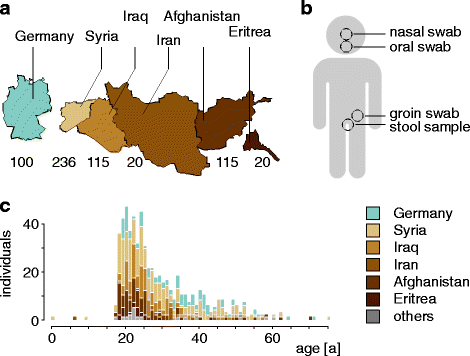
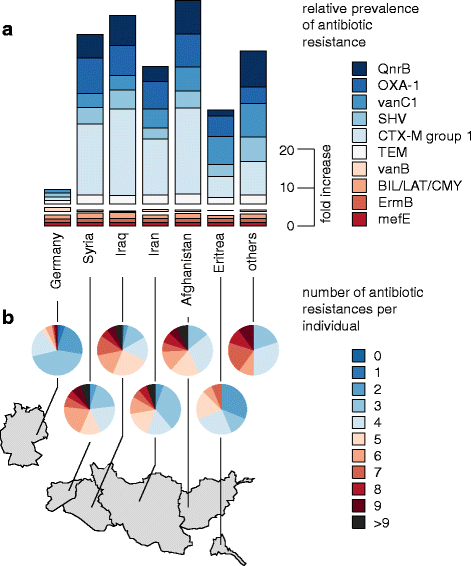
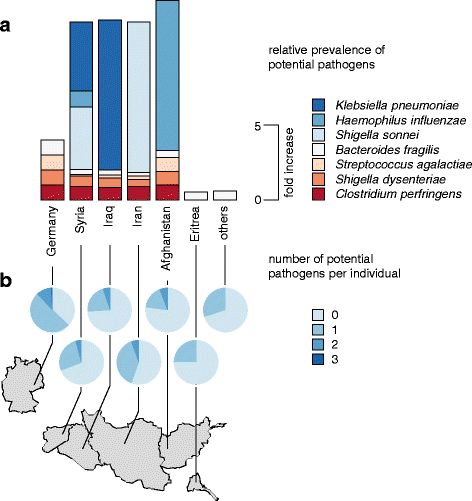
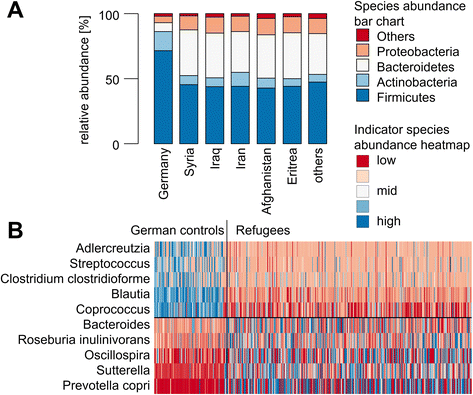
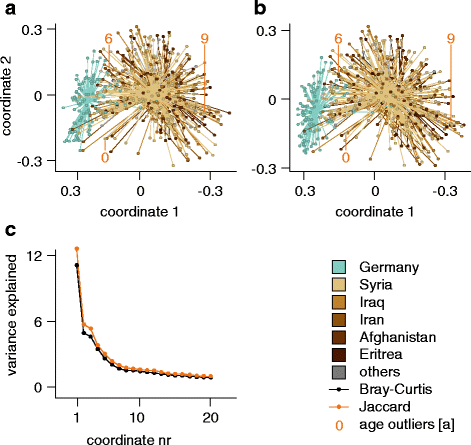
Similar articles
-
No evidence of carbapenemase-producing Enterobacteriaceae in stool samples of 1,544 asylum seekers arriving in Rhineland-Palatinate, Germany, April 2016 to March, 2017.Euro Surveill. 2019 Feb;24(8):1800030. doi: 10.2807/1560-7917.ES.2019.24.8.1800030. Euro Surveill. 2019. PMID: 30808444 Free PMC article.
-
Antibiotic-mediated changes in the fecal microbiome of broiler chickens define the incidence of antibiotic resistance genes.Microbiome. 2018 Feb 13;6(1):34. doi: 10.1186/s40168-018-0419-2. Microbiome. 2018. PMID: 29439741 Free PMC article.
-
High rates of meticillin-resistant Staphylococcus aureus among asylum seekers and refugees admitted to Helsinki University Hospital, 2010 to 2017.Euro Surveill. 2018 Nov;23(45):1700797. doi: 10.2807/1560-7917.ES.2018.23.45.1700797. Euro Surveill. 2018. PMID: 30424828 Free PMC article.
-
Profiles of Microbial Community and Antibiotic Resistome in Wild Tick Species.mSystems. 2022 Aug 30;7(4):e0003722. doi: 10.1128/msystems.00037-22. Epub 2022 Aug 1. mSystems. 2022. PMID: 35913190 Free PMC article. Review.
-
Health condition of Afghan refugees residing in Iran in comparison to Germany: a systematic review of empirical studies.Int J Equity Health. 2023 Jan 21;22(1):16. doi: 10.1186/s12939-023-01832-7. Int J Equity Health. 2023. PMID: 36681845 Free PMC article.
Cited by
-
Immigration and Acculturation: Impact on Health and Well-Being of Immigrants.Curr Hypertens Rep. 2018 Jul 3;20(8):70. doi: 10.1007/s11906-018-0872-0. Curr Hypertens Rep. 2018. PMID: 29971699 Review.
-
The need to increase antimicrobial resistance surveillance among forcibly displaced persons (FDPs).Trop Dis Travel Med Vaccines. 2023 Sep 1;9(1):12. doi: 10.1186/s40794-023-00198-6. Trop Dis Travel Med Vaccines. 2023. PMID: 37653439 Free PMC article. Review.
-
The unique composition of Indian gut microbiome, gene catalogue, and associated fecal metabolome deciphered using multi-omics approaches.Gigascience. 2019 Mar 1;8(3):giz004. doi: 10.1093/gigascience/giz004. Gigascience. 2019. PMID: 30698687 Free PMC article.
-
NOD2 Influences Trajectories of Intestinal Microbiota Recovery After Antibiotic Perturbation.Cell Mol Gastroenterol Hepatol. 2020;10(2):365-389. doi: 10.1016/j.jcmgh.2020.03.008. Epub 2020 Apr 11. Cell Mol Gastroenterol Hepatol. 2020. PMID: 32289499 Free PMC article.
-
Stressor-Specific Microbiota Intervention.Front Nutr. 2022 Apr 18;9:870665. doi: 10.3389/fnut.2022.870665. eCollection 2022. Front Nutr. 2022. PMID: 35520283 Free PMC article.
References
-
- Jim O’Neil. WHO review on antimicrobial resistance. Antimicrobial resistance: tackling a crisis for the health and wealth of nations. UK, HM Government Report: AMR.ORG; 2014 Dec p. 1–20. Report No.: main report.
-
- Section UNNS. UN News—At UN, global leaders commit to act on antimicrobial resistance [Internet]. UN News Serv. Sect. 2016 [cited 2016 Sep 23]. Available from: http://www.un.org/apps/news/story.asp?NewsID=55011#.V-Ty9DWQl0y
-
- European Centre for Disease Prevention and Control, editor. The bacterial challenge, time to react: a call to narrow the gap between multidrug-resistant bacteria in the EU and the development of new antibacterial agents. Stockholm: ECDC; 2009.
-
- Antimicrobial resistance: tackling a crisis for the health and wealth of nations. 2014.
Publication types
MeSH terms
Substances
Grants and funding
LinkOut - more resources
Full Text Sources
Other Literature Sources
Research Materials

